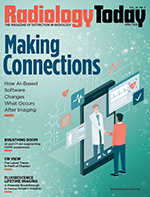 Editor’s Note: Rising to the Challenge
Editor’s Note: Rising to the Challenge
By David Yeager
Radiology Today
Vol. 26 No. 3 P. 4
One aspect of medical imaging that I find fascinating is how the field is constantly evolving to meet the next challenge. Solved a problem? Here are three more! It’s an iterative process, and it continues to drive radiology to the forefront of medical care. In this issue, we have articles about some challenges that have proven difficult to solve. However, with determination and patience, people are taking them on and finding innovative ways to make progress. Many of these technological advances influence how and what radiologists are able to see.
Follow-up recommendations are an ongoing challenge for health care providers. This is particularly true in regard to screening programs that can potentially alert patients to treatable conditions before they become much more difficult to treat. For radiologists, who don’t generally have direct contact with patients, this magnifies the challenge. There are many reasons that follow-up appointments, medical tests, or consultations may not occur, and many ways that health systems and technology companies are trying to narrow the gaps. Jessica Zimmer speaks with experts who are actively engaged in making sure that follow-up recommendations are followed up. Whether it be the use of advanced AI, reaching out to patients directly, or some combination of strategies, getting more patients actively involved in their care is a win for patients and providers.
Another common challenge is lung imaging, especially in the case of COPD. Spirometry is the standard COPD test, but it requires inhalation, a breath hold, and exhalation, which can be difficult, depending on a patient’s degree of disease. New methods show promise for capturing useful images with CT, in some cases with a single image, rather than an inspiratory and expiratory image, alleviating the need for a breath hold. Beth Orenstein reports on the ways that CT and AI are augmenting traditional COPD diagnosis.
Of course, an image is only as good as the monitor it’s viewed on. Keith Loria has a round-up of the latest in monitor technology. Advances in monitor resolution and automation allow radiologists to view images in more settings with more efficient workflow, helping reduce backlogs and burnout. Higher resolution trends in the commercial monitor market are also filtering into the medical market, which will likely continue. For more details, turn to page 18.
We also have articles on fluorescence lifetime imaging for viewing surgical margins during cancer surgery, by Rebekah Moan; using AI to detect signs of heart disease in mammograms, from Loria again; and some interesting MRI news.
Enjoy the issue.
— Dave Yeager
david.yeager@gvpub.com
